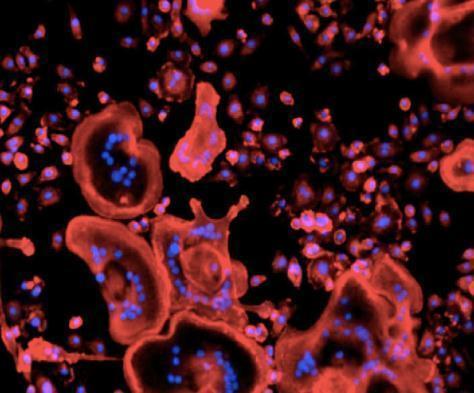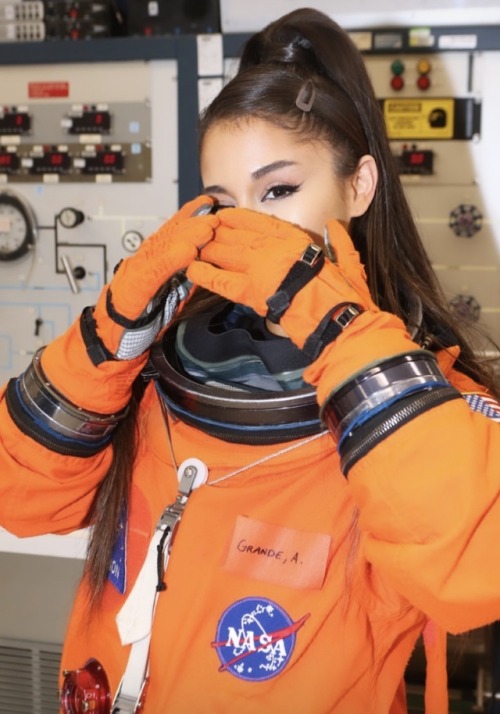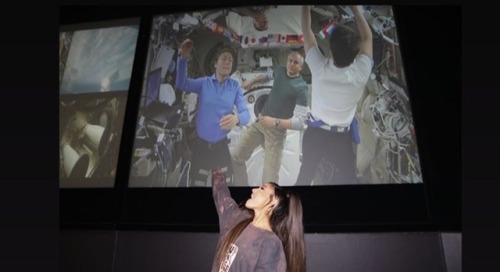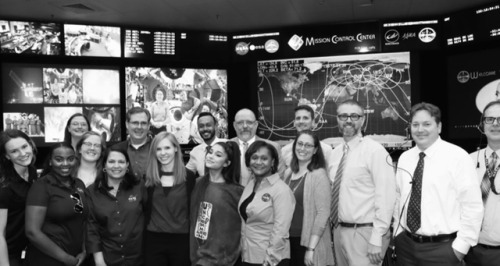Houston, We Have A Launch!
Houston, We Have a Launch!
Today, three new crew members will launch to the International Space Station. NASA astronaut Jeff Williams, along with Russian cosmonauts Alexey Ovchinin and Oleg Skripochka, are scheduled to launch from the Baikonur Cosmodrome in Kazakhstan at 5:26 p.m. EDT. The three Expedition 47 crew members will travel in a Soyuz spacecraft, rendezvousing with the space station six hours after launch.

Traveling to the International Space Station is an exciting moment for any astronaut. But what if you we’re launching to orbit AND knew that you were going to break some awesome records while you were up there? This is exactly what’s happening for astronaut Jeff Williams.
This is a significant mission for Williams, as he will become the new American record holder for cumulative days in space (with 534) during his six months on orbit. The current record holder is astronaut Scott Kelly, who just wrapped up his one-year mission on March 1.
On June 4, Williams will take command of the station for Expedition 48. This will mark his third space station expedition…which is yet another record!
Want to Watch the Launch?

You can! Live coverage will begin at 4:30 p.m. EDT on NASA Television, with launch at 5:26 p.m.
Tune in again at 10:30 p.m. to watch as the Soyuz spacecraft docks to the space station’s Poisk module at 11:12 p.m.
Hatch opening coverage will begin at 12:30 a.m., with the crew being greeted around 12:55 a.m.
NASA Television: https://www.nasa.gov/nasatv
Follow Williams on Social!

Astronaut Jeff Williams will be documenting his time on orbit, and you can follow along on Facebook, Instagram and Twitter.
Make sure to follow us on Tumblr for your regular dose of space: http://nasa.tumblr.com
More Posts from Nasa and Others
What’s your favorite geological feature to view from space? Alternatively, what’s the biggest “duh” moment you’ve had during your career where you had an incorrect, preconceived notion about something. Thanks!
Travel Posters of Fantastic Excursions
What would the future look like if people were regularly visiting to other planets and moons? These travel posters give a glimpse into that imaginative future. Take a look and choose your destination:
The Grand Tour

Our Voyager mission took advantage of a once-every-175-year alignment of the outer planets for a grand tour of the solar system. The twin spacecraft revealed details about Jupiter, Saturn, Uranus and Neptune – using each planet’s gravity to send them on to the next destination.
Mars

Our Mars Exploration Program seeks to understand whether Mars was, is, or can be a habitable world. This poster imagines a future day when we have achieved our vision of human exploration of the Red Planet and takes a nostalgic look back at the great imagined milestones of Mars exploration that will someday be celebrated as “historic sites.”
Earth

There’s no place like home. Warm, wet and with an atmosphere that’s just right, Earth is the only place we know of with life – and lots of it. Our Earth science missions monitor our home planet and how it’s changing so it can continue to provide a safe haven as we reach deeper into the cosmos.
Venus

The rare science opportunity of planetary transits has long inspired bold voyages to exotic vantage points – journeys such as James Cook’s trek to the South Pacific to watch Venus and Mercury cross the face of the sun in 1769. Spacecraft now allow us the luxury to study these cosmic crossings at times of our choosing from unique locales across our solar system.
Ceres

Ceres is the closest dwarf planet to the sun. It is the largest object in the main asteroid belt between Mars and Jupiter, with an equatorial diameter of about 965 kilometers. After being studied with telescopes for more than two centuries, Ceres became the first dwarf planet to be explored by a spacecraft, when our Dawn probe arrived in orbit in March 2015. Dawn’s ongoing detailed observations are revealing intriguing insights into the nature of this mysterious world of ice and rock.
Jupiter

The Jovian cloudscape boasts the most spectacular light show in the solar system, with northern and southern lights to dazzle even the most jaded space traveler. Jupiter’s auroras are hundreds of times more powerful than Earth’s, and they form a glowing ring around each pole that’s bigger than our home planet.
Enceladus

The discovery of Enceladus’ icy jets and their role in creating Saturn’s E-ring is one of the top findings of the Cassini mission to Saturn. Further Cassini discoveries revealed strong evidence of a global ocean and the first signs of potential hydrothermal activity beyond Earth – making this tiny Saturnian moon one of the leading locations in the search for possible life beyond Earth.
Titan

Frigid and alien, yet similar to our own planet billions of years ago, Saturn’s largest moon, Titan has a thick atmosphere, organic-rich chemistry and surface shaped by rivers and lakes of liquid ethane and methane. Our Cassini orbiter was designed to peer through Titan’s perpetual haze and unravel the mysteries of this planet-like moon.
Europa

Astonishing geology and the potential to host the conditions for simple life making Jupiter’s moon Europa a fascinating destination for future exploration. Beneath its icy surface, Europa is believed to conceal a global ocean of salty liquid water twice the volume of Earth’s oceans. Tugging and flexing from Jupiter’s gravity generates enough heat to keep the ocean from freezing.
You can download free poster size images of these thumbnails here: http://www.jpl.nasa.gov/visions-of-the-future/
Make sure to follow us on Tumblr for your regular dose of space: http://nasa.tumblr.com
What's a SPOC? Isn't that a star trek character?
What extra-curricular activities do you suggest to make the most of our time in high school for a job in NASA?
There are so many great things to get into. I regret that I worked mostly in high school and didn’t spend more time in extracurricular activities. If I could go back, I would be more active in sports because that helps with learning about teamwork and keeps you fit. Lastly, I would get involved on an academic team to keep your brain fit.
Name the Mars 2020 Rover!
In 2020, we’re sending our newest robotic scientist to Mars, paving the way for humans to one day live and work on the Red Planet. The only problem? Our Mars 2020 rover doesn’t have a name yet! We’re calling on K-12 students across the country to find the very best name for our next robotic space explorer!
The Mission

Before we can send astronauts to Mars we need to learn more about the planet and its climate. This is where the Mars 2020 rover comes in. Its job will be to explore the Red Planet in search of signs of ancient life! It will also be tasked with characterizing the planet’s climate and geology, and collecting samples from its surface. Because of the groundwork laid by rovers such as this, humans will one day become an interplanetary species!
Meet the rovers that came before it

The-soon-to-be-named rover will be joining the team of historic NASA robots that have been working away in space for the past 27 years! All of our robot explorers have their own missions, personality and names that help tell their own story. The most recent Mars rover, Curiosity, landed on the planet in 2012 and is responsible for finding evidence of a possible ancient oasis! Data Curiosity collected suggests salty, shallow ponds once dotted a Martian crater – a sign of the planet’s drying climate. Before Curiosity, robotic twins Spirit and Opportunity landed on Mars in 2004. Their instruments helped them search for evidence of liquid water that may have been present in the planet’s past!
Submit your entry today!
One grand prize winner will name the rover and be invited to Cape Canaveral, Florida to see the spacecraft launch in July 2020! So, what will it take to win? Just send us your proposed name and a short essay (no more than 150 words), explaining why the name you chose is the best for this very special robotic explorer! The deadline is November 1st, so get your thinking cap on and tell us your most creative idea! Apply here!
Make sure to follow us on Tumblr for your regular dose of space: http://nasa.tumblr.com
What’s On Board the Next SpaceX Cargo Launch?
Cargo and supplies are scheduled to launch to the International Space Station on Monday, July 18 at 12:45 a.m. EDT. The SpaceX Dragon cargo spacecraft will liftoff from our Kennedy Space Center in Florida.

Among the arriving cargo is the first of two international docking adapters, which will allow commercial spacecraft to dock to the station when transporting astronauts in the near future as part of our Commercial Crew Program.

This metallic ring, big enough for astronauts and cargo to fit through represents the first on-orbit element built to the docking measurements that are standardized for all the spacecraft builders across the world.

Its first users are expected to be the Boeing Starliner and SpaceX Crew Dragon spacecraft, which are both now in development.
What About the Science?!
Experiments launching to the station range from research into the effects of microgravity on the human body, to regulating temperature on spacecraft. Take a look at a few:
A Space-based DNA Sequencer

DNA testing aboard the space station typically requires collecting samples and sending them back to Earth to be analyzed. Our Biomolecule Sequencer Investigation will test a new device that will allow DNA sequencing in space for the first time! The samples in this first test will be DNA from a virus, a bacteria and a mouse.
How big is it? Picture your smartphone…then cut it in half. This miniature device has the potential to identify microbes, diagnose diseases and evaluate crew member health, and even help detect DNA-based life elsewhere in the solar system.
OsteoOmics

OsteoOmics is an experiment that will investigate the molecular mechanisms that dictate bone loss in microgravity. It does this by examining osteoblasts, which form bone; and osteoclasts, which dissolves bone. New ground-based studies are using magnetic levitation equipment to simulate gravity-related changes. This experiment hopes to validate whether this method accurately simulates the free-fall conditions of microgravity.
Results from this study could lead to better preventative care or therapeutic treatments for people suffering bone loss, both on Earth and in space!
Heart Cells Experiment

The goals of the Effects of Microgravity on Stem Cell-Derived Heart Cells (Heart Cells) investigation include increasing the understanding of the effects of microgravity on heart function, the improvement of heart disease modeling capabilities and the development of appropriate methods for cell therapy for people with heart disease on Earth.
Phase Change Material Heat Exchanger (PCM HX)

The goal of the Phase Change Material Heat Exchanger (PCM HX) project is to regulate internal spacecraft temperatures. Inside this device, we're testing the freezing and thawing of material in an attempt to regulate temperature on a spacecraft. This phase-changing material (PCM) can be melted and solidified at certain high heat temperatures to store and release large amounts of energy.
Watch Launch!
Live coverage of the SpaceX launch will be available starting at 11:30 p.m. EDT on Sunday, July 17 via NASA Television.
Make sure to follow us on Tumblr for your regular dose of space: http://nasa.tumblr.com
Solar System: 5 Things to Know This Week
From Mars to the asteroid belt to Saturn, our hardworking space robots are exploring the solar system. These mechanical emissaries orbit distant worlds or rove across alien landscapes, going places that are too remote or too dangerous for people (for now).
We often show off the pictures that these spacecraft send home, but this week we’re turning that around: here are some of the best pictures of the space robots, taken by other robots (or themselves), in deep space.
1. So Selfless with the Selfies

The Mars Curiosity rover makes breathtaking panoramas of the Martian landscape — and looks good doing it. This mission is famous for the remarkable self portraits of its robotic geologist in action. See more Martian selfies HERE. You can also try this draggable 360 panorama HERE. Find out how the rover team makes these images HERE.
2. Two Spaceships Passing in the Moonlight

In a feat of timing on Jan. 14, 2014, our Lunar Reconnaissance Orbiter caught a snapshot of LADEE, another robotic spacecraft that was orbiting the moon at the time. LADEE zoomed past at a distance of only about five miles below.
3. Bon Voyage, Galileo

The history-making Galileo mission to Jupiter set sail from the cargo bay of another spacecraft, Space Shuttle Atlantis, on Oct. 18, 1989. Get ready for Juno, which is the next spacecraft to arrive at Jupiter in July.
4. Cometary Close-Up

Using a camera on the Philae lander, the Rosetta spacecraft snapped an extraordinary self portrait at comet 67P/Churyumov-Gerasimenko from a distance of about 10 miles. The image captures the side of Rosetta and one of its 14-meter-long solar wings, with the comet in the background. Learn more about Rosetta HERE.
5. Man and Machine

This snapshot captures a remarkable moment in the history of exploration: the one and only time a human met up in space with a robotic forerunner on location. The Surveyor 3 lander helped pave the way for the astronaut footsteps that came a few years later. See the story of Apollo 12 and this unique encounter HERE.
Want to learn more? Read our full list of the 10 things to know this week about the solar system HERE.
Make sure to follow us on Tumblr for your regular dose of space: http://nasa.tumblr.com

The Space Shuttle Challenger landed #OTD in 1983.
Here are astronauts Richard Truly & Guion Bluford of Space Transport System 8 (STS-8) grabbing some shut-eye before the wrap up of their mission. This mission had:
The first African American, Guion Bluford, to fly in space
The first night launch and landing during the Space Shuttle Program
Make sure to follow us on Tumblr for your regular dose of space: http://nasa.tumblr.com




Ariana Grande got some space at N-A-S-A. Get yours too.
Make sure to follow us on Tumblr for your regular dose of space: http://nasa.tumblr.com.
Hubble’s 5 Weirdest Black Hole Discoveries
Our Hubble Space Telescope has been exploring the wonders of the universe for nearly 30 years, answering some of our deepest cosmic questions. Some of Hubble’s most exciting observations have been about black holes — places in space where gravity pulls so much that not even light can escape. As if black holes weren’t wild enough already, Hubble has helped us make discoveries that show us they’re even weirder than we thought!
Supermassive Black Holes Are Everywhere

First, these things are all over the place. If you look at any random galaxy in the universe, chances are it has a giant black hole lurking in its heart. And when we say giant, we’re talking as massive as millions or even billions of stars!

Hubble found that the mass of these black holes, hidden away in galactic cores, is linked to the mass of the host galaxy — the bigger the galaxy, the bigger the black hole. Scientists think this may mean that the black holes grew along with their galaxies, eating up some of the stuff nearby.
Some Star Clusters Have Black Holes

A globular cluster is a ball of old, very similar stars that are bound together by gravity. They’re fairly common — our galaxy has at least 150 of them — but Hubble has found some black sheep in the herd. Some of these clusters are way more massive than usual, have a wide variety of stars and may even harbor a black hole at the center. This suggests that at least some of the globular clusters in our galaxy may have once been dwarf galaxies that we absorbed.
Black Hole Jets Regulate Star Birth

While black holes themselves are invisible, sometimes they shoot out huge jets of energy as gas and dust fall into them. Since stars form from gas and dust, the jets affect star birth within the galaxy.

Sometimes they get rid of the fuel needed to keep making new stars, but Hubble saw that it can also keep star formation going at a slow and steady rate.
Black Holes Growing in Colliding Galaxies

If you’ve ever spent some time stargazing, you know that staring up into a seemingly peaceful sea of stars can be very calming. But the truth is, it’s a hectic place out there in the cosmos! Entire galaxies — these colossal collections of gas, dust, and billions of stars with their planets — can merge together to form one supergalaxy. You might remember that most galaxies have a supermassive black hole at the center, so what happens to them when galaxies collide?

In 2018, Hubble unveiled the best view yet of close pairs of giant black holes in the act of merging together to form mega black holes!
Gravitational Wave Kicks Monster Black Hole Out of Galactic Core

What better way to spice up black holes than by throwing gravitational waves into the mix! Gravitational waves are ripples in space-time that can be created when two massive objects orbit each other.

In 2017, Hubble found a rogue black hole that is flying away from the center of its galaxy at over 1,300 miles per second (about 90 times faster than our Sun is traveling through the Milky Way). What booted the black hole out of the galaxy’s core? Gravitational waves! Scientists think that this is a case where two galaxies are in the late stages of merging together, which means their central black holes are probably merging too in a super chaotic process.
Want to learn about more of the highlights of Hubble’s exploration? Check out this page! https://www.nasa.gov/content/goddard/2017/highlights-of-hubble-s-exploration-of-the-universe
Make sure to follow us on Tumblr for your regular dose of space: http://nasa.tumblr.com
-
 texmexirican reblogged this · 5 years ago
texmexirican reblogged this · 5 years ago -
 violetsystems reblogged this · 6 years ago
violetsystems reblogged this · 6 years ago -
 morallyambiguoussodacan liked this · 6 years ago
morallyambiguoussodacan liked this · 6 years ago -
 andromeda--collision liked this · 7 years ago
andromeda--collision liked this · 7 years ago -
 boldlybeautifulhologram-blog liked this · 7 years ago
boldlybeautifulhologram-blog liked this · 7 years ago -
 hotdesert-50-blog liked this · 8 years ago
hotdesert-50-blog liked this · 8 years ago -
 dobie56 liked this · 8 years ago
dobie56 liked this · 8 years ago -
 opadillazayas reblogged this · 9 years ago
opadillazayas reblogged this · 9 years ago -
 opadillazayas liked this · 9 years ago
opadillazayas liked this · 9 years ago -
 jsbustaman liked this · 9 years ago
jsbustaman liked this · 9 years ago -
 paulabittencourtlima-blog liked this · 9 years ago
paulabittencourtlima-blog liked this · 9 years ago -
 spurioustime liked this · 9 years ago
spurioustime liked this · 9 years ago -
 azyaxxi-blog reblogged this · 9 years ago
azyaxxi-blog reblogged this · 9 years ago -
 meflabtechie-blog liked this · 9 years ago
meflabtechie-blog liked this · 9 years ago -
 idontreallydraw reblogged this · 9 years ago
idontreallydraw reblogged this · 9 years ago -
 thingsmydadmightlike-blog reblogged this · 9 years ago
thingsmydadmightlike-blog reblogged this · 9 years ago -
 avimolls liked this · 9 years ago
avimolls liked this · 9 years ago -
 abeltink liked this · 9 years ago
abeltink liked this · 9 years ago -
 weird-is-all-ive-got reblogged this · 9 years ago
weird-is-all-ive-got reblogged this · 9 years ago -
 dvasxmeka reblogged this · 9 years ago
dvasxmeka reblogged this · 9 years ago -
 monicaoakwood reblogged this · 9 years ago
monicaoakwood reblogged this · 9 years ago -
 agnt-romanov reblogged this · 9 years ago
agnt-romanov reblogged this · 9 years ago -
 upper-casey liked this · 9 years ago
upper-casey liked this · 9 years ago -
 inknpaperlove liked this · 9 years ago
inknpaperlove liked this · 9 years ago -
 nasalangley liked this · 9 years ago
nasalangley liked this · 9 years ago -
 computer--cats liked this · 9 years ago
computer--cats liked this · 9 years ago -
 seniba42 reblogged this · 9 years ago
seniba42 reblogged this · 9 years ago -
 kelkat9 reblogged this · 9 years ago
kelkat9 reblogged this · 9 years ago -
 whoinwhoville reblogged this · 9 years ago
whoinwhoville reblogged this · 9 years ago -
 kendo2016-blog liked this · 9 years ago
kendo2016-blog liked this · 9 years ago -
 riptheripper-world-blog liked this · 9 years ago
riptheripper-world-blog liked this · 9 years ago -
 get-lost-in-imagination liked this · 9 years ago
get-lost-in-imagination liked this · 9 years ago -
 forsy liked this · 9 years ago
forsy liked this · 9 years ago -
 lifekook liked this · 9 years ago
lifekook liked this · 9 years ago -
 primordial-soupp-blog reblogged this · 9 years ago
primordial-soupp-blog reblogged this · 9 years ago -
 jikoolaid liked this · 9 years ago
jikoolaid liked this · 9 years ago -
 watsit2u1-blog reblogged this · 9 years ago
watsit2u1-blog reblogged this · 9 years ago -
 carolinec-lima liked this · 9 years ago
carolinec-lima liked this · 9 years ago -
 hellohihellohibye liked this · 9 years ago
hellohihellohibye liked this · 9 years ago
Explore the universe and discover our home planet with the official NASA Tumblr account
1K posts